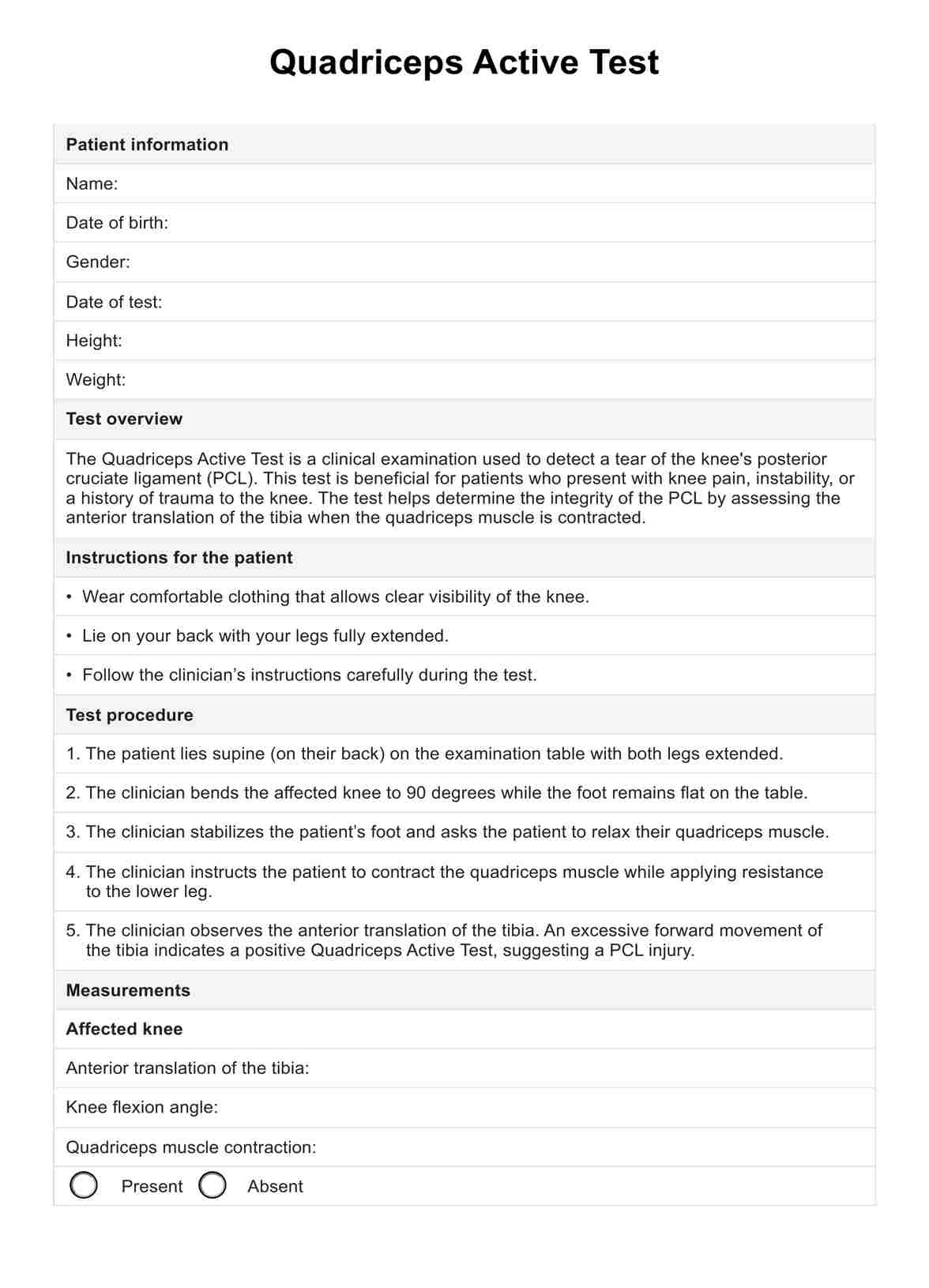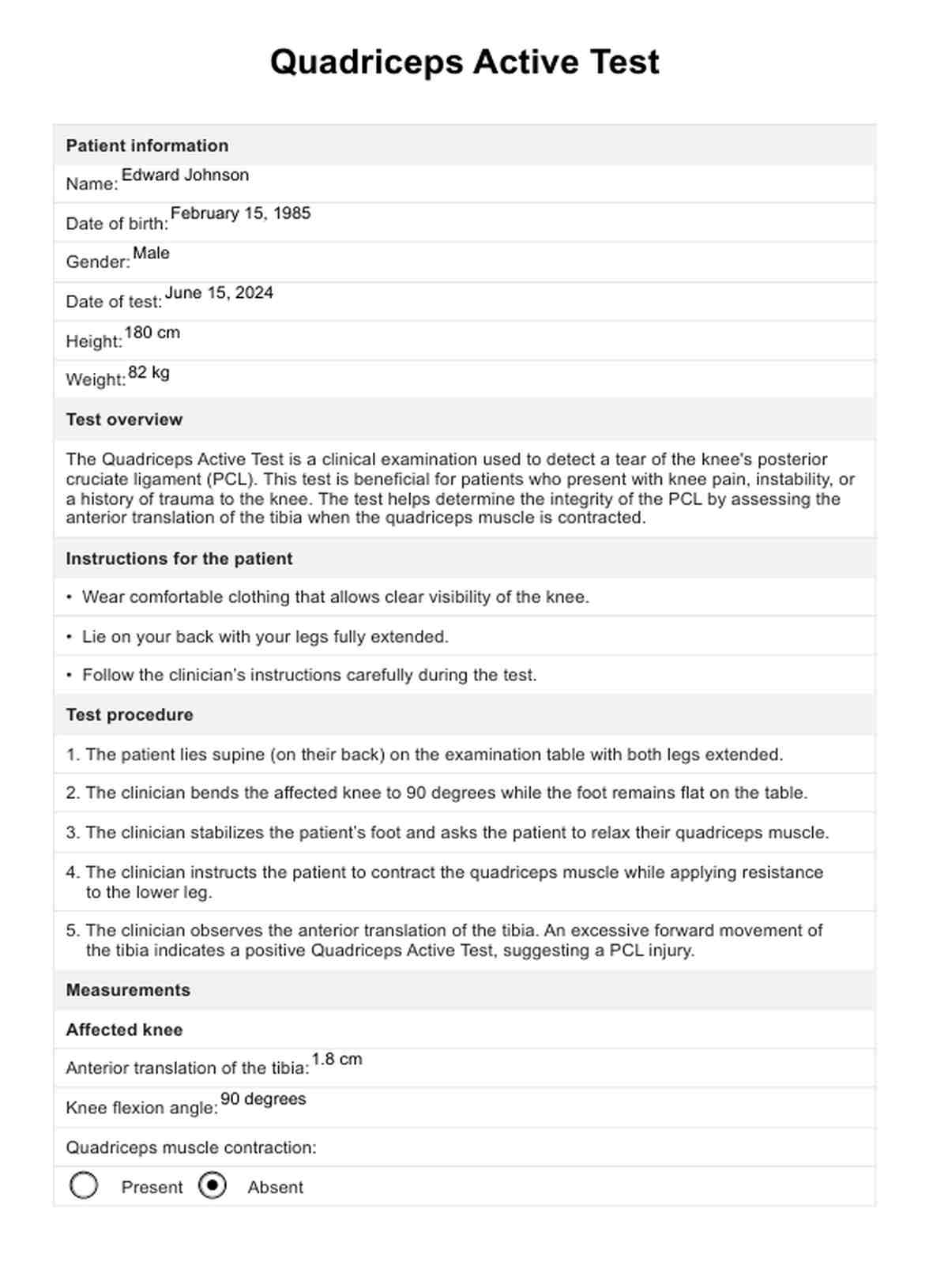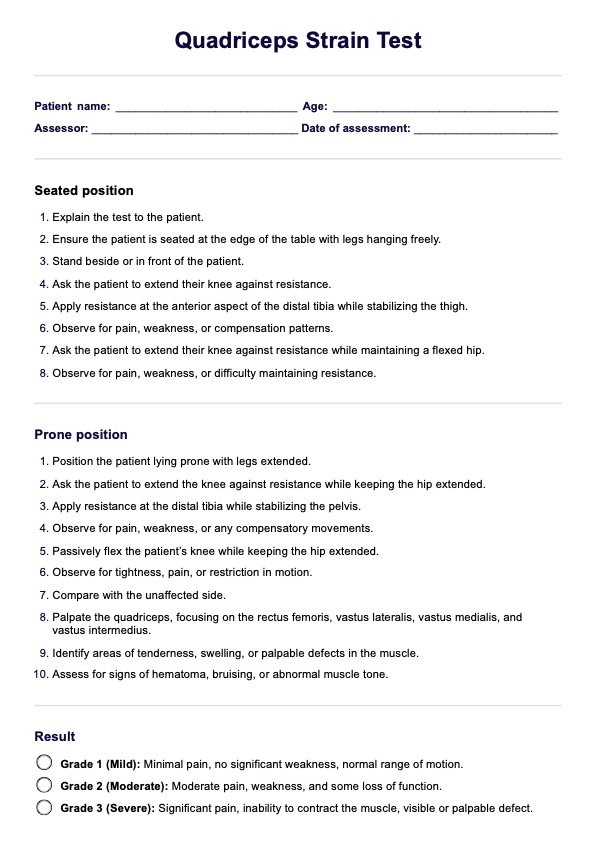Quadriceps Active Test
Streamline your physical therapy practice with our Quadriceps Active Test template. Improve accuracy, efficiency, and patient outcomes with Carepatron's comprehensive software.


What is the Quadriceps Active Test?
The Quadriceps Active Test is a clinical assessment used to measure posterior laxity in patients with posterior cruciate ligament (PCL) injuries. This test is beneficial for patients who have experienced trauma to the knee, such as those involved in sports injuries, car accidents, or falls that result in hyperextension or direct impact.
This test helps healthcare professionals quickly and effectively determine the integrity of the PCL and plan appropriate treatment or further diagnostic steps.
Quadriceps Active Test Template
Quadriceps Active Test Example
How to perform the Quadriceps Active Test
The Quadriceps Active Test is reliable for identifying posterior cruciate ligament injuries. This test helps evaluate the anterior translation of the tibia when the quadriceps muscle contracts. Follow these steps to ensure accurate assessment and documentation using our comprehensive template.
Step 1: Download and prepare the template
First, download and print our comprehensive Quadriceps Active Test template to record patient information, measurements, and observations.
Step 2: Position the patient and begin the test
Have the patient lie supine (on their back) on the examination table with both legs extended. Bend the affected knee (the one with the posterior cruciate ligament disruption) to 90 degrees of knee flexion while ensuring the patient’s foot remains flat on the table.
Step 3: Stabilize and apply resistance
Stabilize the patient’s foot and instruct the patient to relax their quadriceps muscle. Ask the patient to contract the quadriceps muscle while you apply resistance to the lower leg.
Step 4: Measure and observe the tibia
Carefully observe the anterior translation of the proximal tibia. Use a ruler or measuring tape to measure the tibial movement. Record the measurements on the template.
Step 5: Compare both knees
Repeat the test on the unaffected knee for comparison. Document the measurements and any differences in tibial movement. The medial femoral condyle should not move significantly in a knee with an intact PCL.
Step 6: Record and interpret
Fill in the template with all observed measurements, patient feedback, and clinical notes. Use the recorded data to determine if there is a significant difference in tibial movement, indicating a positive test and a potential PCL tear.
By following these steps and using our template, healthcare professionals can efficiently perform and document the Quadriceps Active Test to assess for PCL injuries.
Results and interpretation of the Quadriceps Active Test
The Quadriceps Active Test helps diagnose PCL injuries by assessing the anterior tibial translation in different knee positions. Here’s a detailed interpretation based on the template:
- Positive result: An anterior tibial translation of 5 mm or more when the quadriceps are activated indicates a potential PCL injury.
- Negative result: The PCL is likely intact if there is no significant anterior tibial translation (less than 5 mm) when the quadriceps are activated.
- Pain and discomfort: It is essential to note any pain or discomfort during the test. Increased pain may suggest an acute injury or other underlying issues.
- Additional observations: Weakness, instability, or changes in the patient's pain levels during the test provide further insights into the knee’s condition.
Accurate interpretation allows healthcare professionals to diagnose PCL injuries effectively, guiding decisions on further diagnostic tests, treatment plans, and rehabilitation strategies.
Benefits of using our template
Using our Quadriceps Active Test template offers several advantages:
- Structured format: Ensures all critical aspects of the test are documented comprehensively and consistently.
- Efficiency: Streamlines the documentation process, saving valuable time and reducing the risk of errors.
- Enhanced reliability: Provides a standardized approach, improving the reliability of assessments and tracking patient progress effectively.
- Clear sections: Includes designated areas for patient information, test procedures, results, and interpretation, facilitating thorough and precise evaluations.
Using our template, clinicians can ensure detailed and accurate documentation, which can lead to better diagnostic accuracy and more effective treatment plans.
Commonly asked questions
The Quadriceps Active Test diagnoses posterior cruciate ligament (PCL) injuries by assessing the anterior tibial translation when the quadriceps are activated.
Patients experiencing knee pain, instability, or suspected PCL injuries, especially after trauma or sports injuries, should undergo the Quadriceps Active Test for accurate diagnosis.
Using a standardized template ensures consistent and comprehensive documentation, improving diagnosis accuracy and subsequent treatment plans' effectiveness.








































































































